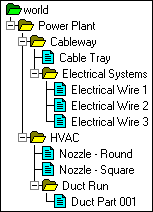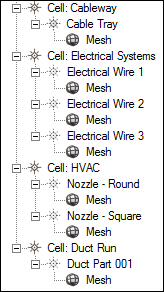| You are here: Home » Import CAD Formats » NGRAIN's 3KO Solutions |
|
The Okino "DGN" export converter module allows various types of 3D geometry, hierarchy and materials (assembly data) to be exported to native .dgn v8 disk based files which are usually associated with the Bentley MicroStation program.
The corresponding DGN importer online documentation can be found here.
The 'DGN' importer and exporter are sold as part of the optional Granite/Pack add-on module. It can be ordered online or directly by email/phone/fax ordering.
Click on any one of the small screen snapshots to jump to the corresponding section of this WEB page:
| Main | Selective Ouput | Lights | Materials |
|---|---|---|---|
![[1]](exp_dgnsml1.gif) |
![[2]](exp_dgnsml2.gif) |
![[3]](exp_dgnsml3.gif) |
![[4]](exp_dgnsml4.gif) |
| Curves | Mesh | Bitmaps | File Paths |
|---|---|---|---|
![[5]](exp_dgnsml5.gif) |
![[5]](exp_dgnsml7.gif) |
![[6]](exp_dgnsml8.gif) |
![[7]](exp_dgnsml6.gif) |
- A plethora of options across 8 panels to provide you with great control over the DGN
scene export process.
- All main DGN geometry types supported: NURBS surfaces, NURBS curves (exported as a BREP “wire”
object), 3D polylines, 3D point sets and polygonal meshes with vertex normals, (u,v) texture coordinates
and vertex colors.
- Automatic cross conversion of NURBS curves, spline curves and spline shapes into either DGN
NURBS curves or DGN polylines. Control is provided through dialog box options. Closed curves marked as
“renderable” can also be output as either trimmed NURBS surfaces or meshes.
- Exports point, spot and directional light sources and their related parameters. 18 predefined
light configurations are made available, which allows lights to be automatically added to the exported
DGN scene if none are available in the source scene.
- Embedding of almost every possible 2D bitmap file format inside DGN files (complete list of
supported formats is listed on this Okino
WEB page). If you do not wish to embed the 2D bitmap images, then support exists for automatic
bitmap conversion to a desired 2D file format for file referencing from within the DGN file.
- Material export including ambient/diffuse/specular/luminous colors, shading coefficients, associated
diffuse texture map, opacity, Phong shininess and dozens of options to override or tweak any of
these parameters prior to exporting.
- Export of "meta data" (DGN object properties) information on DGN nodes.
- Mesh geometry tweaking, modification and transformations via automated operations made available
by Okino's suite of polygon reduction and transformation routines. Ideal as a means to "clean up"
the source meshes and apply 80-95% pre-polygon reduction to the models prior to export to DGN
- Fine control over the DGN compression methods used to take the polygonal mesh data and apply
lossy or lossless compression techniques prior to file creation.
- Direct control over all of the major DGN toolkit options used to create the final DGN file.

Flip 'Y'-Up to 'Z'-Up coordinate system
This option allows the default coordinate system to be set for the DGN file. It defines what will be considered the "Up" axis in the exported DGN file. Okino software uses a "Y" up coordinate system. Enabling this option will flip the source Y-up data of the internal Okino scene graph to a Z-up coordinate system of the exported DGN file.Use Geometry Instancing to Reduce File Size (place geometry within 'shared cell definitions')
If this checkbox is checkmarked then the mechanism of "instancing" will be used to try and keep the size of the exported file as small as possible. For example, if the source scene has 1000 bolts all derived from the same mesh primitive data, and the 1000 items have been placed in the Okino scene graph via "instancing" then during export only a single copy of the geometry mesh data will be exported, but with 1000 virtual copies made of it. These virtual copy instances merely act as indexes to the original mesh primitive data instead of being full copies, which can significantly reduce the size of the final output.
The geometry data will be placed within DGN "shared cell definitions" which will be instanced via DGN "shared cell instances".
If this checkbox is disabled then unique and explicit copies of mesh data will be output to the file regardless of whether each copy is exactly the same as previous copies already exported.
Force all geometry to use 'shared cell definitions' (also allows geometry to retain their names)
DGN files do not allow geometry parts to have names associated with them. To get around this limitation, this checkbox can be enabled in which case every geometry part (a "mesh node" in the following screen snapshots) will be output under a named "shared cell definition" node which has the ability to retain the name of its child geometry. The following screen snapshots show an example of having this option disabled (left diagram) and enabled (right diagram).

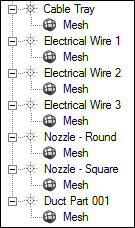
Another obvious use of this option is to force every geometry item to be placed within its own DGN 'shared cell definition', each of which can then be easily instanced in MicroStation as a 'shared cell instance'.
Note 1: enabling this option can potentially cause problems whereby several different instances of a single object definition inherits different instance-level materials. For example, if you have one sphere object, but instantiate it twice, and apply a 'red' material to some polygons of the sphere in instance 1, and a 'blue' material to some polygons of the sphere in instance 2, then the final DGN scene may not look correct since only a single sphere with a 'red' material can be exported.
Note 2: this does not apply to 2d text geometry when the "Output Text As... 2D Vector Font Data" option is enabled on the "Selective Output" panel. 2D procedural (vector font) text cannot use shared cell definitions since the transformation data must be extracted and embedded with the text primitive itself.
Note 3: enabling this checkbox will cause the DGN "shared cell definition" to have a name derived from the first Okino 'instance' of that object definition. The following diagrams exemplify where this may cause problems. In this contrived example we have defined a single geometry object definition and created 3 Okino instances of it, named "Electrical Wire 1", "Electrical Wire - Copy 2" and "Electrical Wire - Copy 3".
Okino Scene & Part HierarchyWhen exported to DGN and viewed within MicroStation, all 3 copies will have the name of the first Okino instance, that being "Electrical Wire 1".
MicroStation Scene & Part HierarchyWhy does this occur? It is because the DGN file format does not allow a unique name to be associated with each 'instance'. Rather, a name can only be assigned to the original 'object definition' (DGN 'shared cell definition') from which each instance is cloned. MicroStation only shows the names of the original 'shared cell definition' and hence the 3 unique instance names are not shown. This is a limitation of the DGN file format and not of this exporter.
Measurement Units for Exported File
This combo box determines how the internal scene units will be matched to those which DGN can understand and accept.
For example, if the internal scene is defined using "kilometers" but this combo box is set to "Scale scene to meters" then the DGN file will be output to use "meters" and all geometry will be scaled 1000 times larger.
** NOTE ** DGN uses millimeters as the implicit unit type for all of its internal data. Hence, if you wish to consider geometry to be in virtual 'meters' after being exported to a DGN file then you need to ensure that one of the 'Scaling' options are chosen from this combo box such as "Scale scene to meters" or "Use current scene units".
Even though the virtual units for the DGN file may be set to meters (as a pure example), that has no relation to the actual scaling of the geometry itself. Hence, as a pure example, you need to ensure that the geometry itself is scaled to some desired unit such as 'inches' even though the virtual units specified for the DGN file may be something other than 'inches' - in other words, a program which loads in this file may show on its user interface that the scene is defined in 'meters' but in reality the raw geometry data is to be interpreted and considered as being in inches.
Use current scene units (scale if necessary)
If this combo box option is chosen then the exported DGN virtual file units will be made the same as the internal scene units. If no match is possible then the exported file will use meters.
The geometry of the exported scene may also be scaled larger or smaller in order to provide exact unit matching (for example, if the internal scene is defined using "kilometers" then the DGN file will be written as "meters" and all geometry will be scaled 1000 times larger due to the fact that DGN does not support kilometer units).
Use current scene units (no scaling) == default method
If this combo box option is chosen (which is the default) then the exported DGN virtual file units will be made the same as the internal scene units. If no match is possible then the exported file will be set to use meters.
No scaling of the geometry will be made if there is no direct mapping of the internal units to the exported DGN units as is done by the previous option.
Blindly set to inches (no scaling)
Blindly set to feet (no scaling)
Blindly set to millimeters (no scaling)
Blindly set to centimeters (no scaling)
Blindly set to meters (no scaling)If any of these combo box options are chosen then the exported DGN virtual file units will be explicitly set to inches, feet, mm, cm or meters, regardless of what the internal units are from the source Okino 3D model.No scaling of the geometry will be made. This simply overrides the "Length Units" shown in the "Model Info" dialog box within DGN.
Scale scene to inches
Scale scene to feet
Scale scene to millimeters
Scale scene to centimeters
Scale scene to metersIf any of these combo box options are chosen then the exported DGN virtual file units will be set to inches, feet, mm, cm or meters, regardless of what the internal units are from the source Okino 3D model.If the current internal Okino scene units are not the same as the chosen DGN export unit format (as defined by this combo box) then the exported geometry will be scaled larger or smaller so that the units will match.
Raw Geometry Scaling Factor
This type-in value scales the exported geometry by the specified amount. Thus, a value of 100 will scale the geometry larger by a factor of 100 while a value of 0.01 will scale the geometry smaller by a factor of 100. The value must not be zero.
Hierarchy (Grouping) output method
This combo box determines what methods will be used to simulate the hierarchical (assembly or grouping) nature of the source 3D scene as it goes out to the DGN file.
MicroStation, and its DGN file format, does not allow for "geometry hierarchy" per se. "Hierarchy" is where one geometry object is allowed to be the parent of another geometry object, in a recursive manner (in CAD programs this is called the 'assembly', for which the assembly groups together the geometry 'part' files).
The options listed in this drop-down combo box are best explained via a real world example. Let's use an example whereby we will be exporting a 3D model of a power plant which is defined by an assembly (hierarchy) of geometry parts. The following screen snapshot is from Okino's stand-along 3D software, showing the assembly (grouping, hierarchy) information as recursive/parented yellow grouping folders, and the geometry items shown as turquoise icons.
Okino Scene & Part HierarchyRecursive Okino 'grouping folders' to parented DGN 'cell headers'
This is the default mode. The original scene's hierarchy will be closely recreated in the DGN file via one 'cell header' for each source model's 'grouping node' (yellow folder). This is done via the DGN file's 'cell header' element.
The following diagrams exemplify what the hierarchy will look like inside of MicroStation:
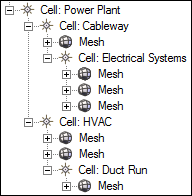
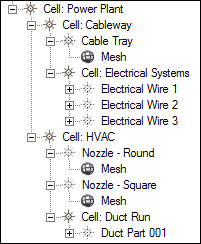
(The right diagram has the optional 'Force all geometry to use shared cell definitions' checkbox enabled which causes every geometry item (mesh nodes in our example) to have its owned 'named' cell header. If you disable this option then the names of each geometry part cannot be output to the DGN file).
Pros: A very close approximation of the source model's assembly hierarchy as DGN recursive DGN 'cell headers'.
Cons: Clicking on any part of a loaded DGN file within the MicroStation user interface will cause all parts within the cell-header hierarchy to be selected at the same time. In other words, you cannot mouse-click to select individual parts of the model on the user interface. To do so, you need to mouse-click to select the parts (or press Control-A to select all), press the 'i' ('Element Information') button, and then select individual parts in the tree hierarchy dialog box which appears.
Each Okino 'grouping folder' to one DGN 'cell header'. No parenting.
No assembly hierarchy will be output except for the bottom-most grouping folders which group together geometry items.
The following diagrams exemplify what the hierarchy will look like inside of MicroStation:
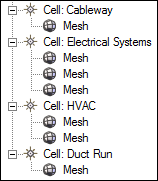
(right diagram = "Force all geometry to use shared cell definitions" enabled)Pros: Compared to the previous option above, more geometry part objects will be selectable via a mouse-click within the MicroStation user interface - doing a mouse click over top of geometry will allow you to individually select objects which are within the same 'cell header' as show in the screen snapshot above, but you will not be able to mouse-click on individual geometry items which are contained within each cell header.
Cons: None of the assembly hierarchy will be output to the DGN file except the bottom-most grouping folders.
Flat hierarchy - no hierarchy, no cell header groupings.
This option does not try to retain any grouping or hierarchy. Every geometry object will be placed in the DGN file with no "cell header" usage, and hence all objects will have a 'flat' hierarchy.
The following diagrams exemplify what the hierarchy will look like inside of MicroStation:

(right diagram = "Force all geometry to use shared cell definitions" enabled)Pros: Every geometry part object will be selectable via a mouse-click within the MicroStation user interface - doing a mouse click over top of geometry will allow you to individually select such objects.
Cons: No assembly hierarchy (grouping) information will be output to the DGN file, and hence it may be more difficult to determine how all the geometry parts within a large DGN file are actually to be grouped together.
Levels (Layer) Creation Method:
This combo box determines how the 3D geometry of the DGN scene will be split up into different MicroStation 'levels' (otherwise known as 'layers' in other modeling programs such as AutoCAD).
In a 3D modeling program it has been customary to have a 'layer table' which allows the geometry within the scene to be split up onto different layers, just as a draftsperson may design a house using different layers of paper. In MicroStation this is referred to as 'levels' and not its equivalent of 'layers'. Levels are very important, critical and core to the MicroStation software - each level can have different display attributes, different per-level color overrides for geometry and many more level-related attributes.
In more traditional MCAD modeling programs and animation/DCC creation programs, as well with Okino software, the geometry is contained instead in 'distinct part objects' and not split up by level/layers, such that the walls of a house are in a geometry object called 'walls', the roof in an object called 'roof', etc. Thus, this combo box basically determines how each 3D geometry object definition as defined inside the Okino software is to be re-arranged to be output to the DGN file in different 'levels' (layers).
The options listed in this drop-down combo box are best explained via a real world example. Let's use an example whereby we will be exporting a 3D model of a power plant which is defined by a number of geometry parts. The following screen snapshot is from Okino's stand-along 3D software, showing the distinct geometry items as turquoise icons.
Okino Scene & Part HierarchyAll geometry output to the 'default' level.
All geometry items placed in the DGN file will be associated with the 'default' level only. In general, this will not be very useful.
For our example, each turquoise colored icon of the diagram above will be associated with a single level named 'default'.
Each geometry item to its own 'numbered' level
Each geometry item placed in the DGN file will be associated with its own unique, ascending, nameless level number.

Level name from 'Instance Name' of each geometry item.
Each geometry item placed in the DGN file will be associated with its own unique level whose name will come from the original 'instance' name of the source geometry object.
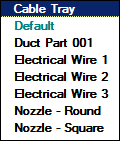
The downside of this approach is that a scene with a huge number of geometry items will create an overabundance of DGN levels'. Normally you do not want to create a large number of levels for any one specific file.
Level name from 'Grouping Folder' holding geometry item, else 'Default' level.
All geometry items which are grouped together using a 'Grouping Folder' within the source Okino 3D scene will be placed together on the same level within the DGN file, with the name of the level coming from the name of the Okino grouping folder.
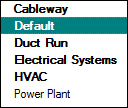
This is a good and useful level output method because it keeps the overall number of levels to a minimum, and segments the DGN model's geometry in a similar manner as it was segmented within the Okino 3d source scene.
Level name from concatenation of all parent 'Grouping Folders' of a geometry item.
This method is quite similar to the previous method, except that the name of the final DGN level is created as the concatenation of all parented 'grouping folders' which contain each geometry part.
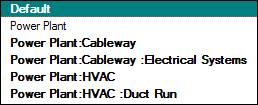
This allows for the most concise transfer of geometry item grouping information from the source 3D scene into the DGN file as equivalent 'levels'.
This panel controls the output of geometric items (meshes, trimmed NURBS and bicubic patches), materials and texture definitions.
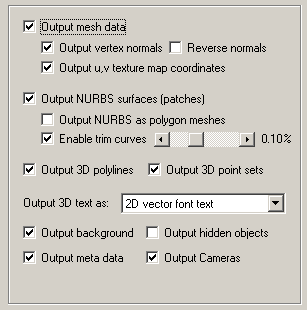
Output mesh data
If this checkbox is checkmarked then mesh geometry will be exported.Output vertex normals
If this checkbox is checkmarked then vertex normals will be exported along with the mesh geometry. Vertex normals are required to provide the "smoothing" information for a mesh model.NOTE: This option is presently disabled since the Teigha.DGN toolkit does not provide any methods to output vertex normals to DGN files.
Reverse Normals
If this checkbox is checkmarked then all vertex normals will be mirrored (inverted or reversed). You may want to try this option if the rendered DGN model looks unnaturally dark, or if the model appears inside out.See also the "Reverse orientation of all polygons" option on the Mesh Processing Options panel.
Output u,v texture map coordinates
If this checkbox is checkmarked then (u,v) vertex texture coordinates will be exported along with the mesh geometry. These are needed if you wish to assign texture map images to a mesh.NOTE: This option is presently disabled since the Teigha.DGN toolkit does not provide any methods to output vertex uv coordinates to DGN files. Hence, texture mapped polygons are not possible at this time.
Output vertex colors
If this checkbox is checkmarked then vertex colors will be exported along with the mesh geometry. These are rarely found in 3D mesh models. Sources of vertex colors are game file formats, OpenFlight, 3ds Max and Maya.Output NURBS surfaces (patches)
If this checkbox is checkmarked then trimmed NURBS surfaces will be exported, either in raw form or as converted polygon meshes.Output NURBS as polygon meshes
If this checkbox is checkmarked then the raw trimmed NURBS will be tessellated into a polygon mesh prior to export. If it remains uncheckmarked then the raw trimmed NURBS data will be exported directly.Output NURBS trim curves
If the above option is disabled (pure NURBS output enabled) then this checkbox determines whether trim curves will be output along with the parent trimmed NURBS surfaces. Trim curves define the outer boundary of a NURBS patch as well as specifying internal trim holes and islands.DGN requires that the trim curves be linearlized. The slider allows the quality of the final polylines to be set. Moving the slider to the left will result in more polyline points (better quality).
Output 3D Line Sets
If this checkbox is checkmarked then all indexed line set primitives will be output. Each indexed line set primitive can have one or more lines, each line having 2 or more vertices. 3D line sets can also have optional vertex colors.Output 3D Point Sets
If this checkbox is checkmarked then all 3D point set (point cloud) primitives will be output. 3D point sets can also have optional vertex colors.Output Text As...
MicroStation handles text as 2D procedural font data, as is done in most graphics software. However, Okino software creates text as 3D extruded mesh data. This combo box determine how Okino's 3D text will be output to DGN.3D polygon meshes
This is the most accurate representation for Okino 3D text. The exact text, with optional extrusions and side walls, will be output to the DGN file as mesh data.2D vector font text
This is an approximation method. The text letters will be output to the DGN file as 2D procedural font data, and not explicit mesh data. For example, the letters 'ABC' will be sent to the DGN file as 3 alphabetic letters 'ABC'.Output Background
If this checkbox is checkmarked then the background color will be output to the file.Output Meta Data
The DGN file format allows for "meta data" information to be associated with each DGN scene element.The following internal Okino scene graph meta data types are supported when exporting to DGN: strings, shorts, ints, floats, colors, vectors, double precision vectors, 4x4 matrices, 4x4 double precision matrices, time, double precision floats, 4 valued vectors, and 4-valued double precision vectors. All numeric values will be converted into meta data string for output to DGN.
Output Hidden Objects
If this checkbox is checkmarked then objects which are tagged as being "hidden" will be output to the DGB file, whereas unchecking this checkbox will prevent hidden objects from being exported to the DGN file.Output Cameras
If this checkbox is checkmarked then all parameters associated with a camera definition will be output.
This panel controls the output of point, spot and directional light sources to the DGN file.
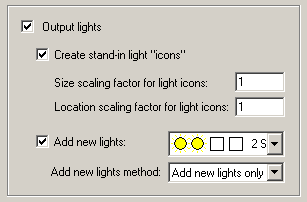
Output Lights
If this checkbox is checkmarked then all light sources of the current 3D scene will be exported to the DGN file, including those parameters for ambient, point, spot and directional light sources.Create Stand-in Light "Icons"
MicroStation scenes often have a stand-in gobo geometry object to represent their light sources. By enabling this checkbox a representative geometry object will be added to the DGN for each light source type. The DGN cell header will be set to 'construction class' geometry.Point light - 32 line segments
Spot light - a cone and cylinder which forms a 'flash light' icon
Directional light - a directional arrow that points towards the light source
Size Scaling Factor for Light Icons
This type-in box allows the size of the gobo to be scaled.Location Scaling Factor for Light Icons
This type-in box allows the location of the gobo to be scaled up or down relative to its default location.Add New Lights
If this checkbox is checkmarked then new lights will be added to the DGN file. The pre-defined light locations, color and light types are chosen from the following drop-down combo box.
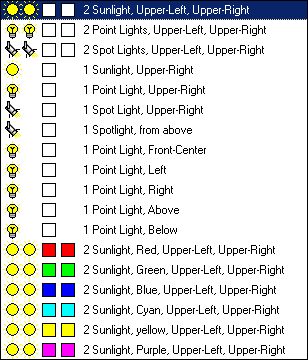
- The first two icons represent the light type (Sun = directional light, Light bulb = point light, Spot light = spot).
- The second two squares represent the color of each of these two light sources.
- The text describes the location of the new light sources (see image below for visual locations).
The new light sources will be placed according to the following image, along the XY plane. If you are looking down the Z axis (towards the negative Z axis) then upper-left will be (1), upper-right will be (3), lower-left will be (7) and lower-right will be (9).
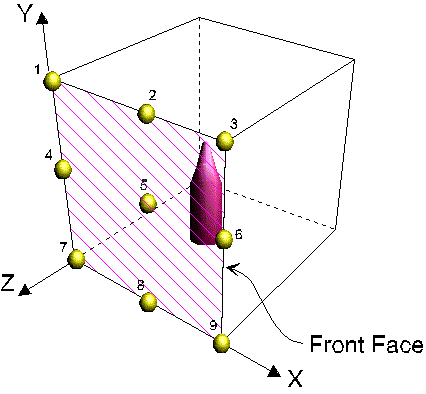
Add New Lights Method
This combo box determines how the new lights are to be added to the exported DGN file.Merge with existing lights in the scene
This option will cause the newly chosen lights (from the drop-down combo box mentioned above) to be added to the already existing lights of the current 3D scene. In other words, all the lights of the current 3D scene will be output first, followed by the 1 or 2 new lights you have chosen from the drop-down visual list.Replace existing lights in the scene
This option will cause the newly chosen lights (from the drop-down combo box mentioned above) to be output to the DGN file, but no other light sources. None of the light sources in the original 3D scene will be output to the DGN file.Add new lights only if there are no existing lights in the scene
This option will cause the newly chosen lights (from the drop-down combo box mentioned above) to be output to the DGN file, but only if there are no existing lights in the original 3D scene. This is the default option. It will ensure that there are at least 1 or 2 new light sources added to the DGN scene if no lights exist in the original 3D scene.
Materials and texture maps are assigned to mesh objects in DGN files via material definitions. This panel controls the output of the material definitions, their associated texture maps, and provide fine grained control over the tweaking and modification of each DGN material property.
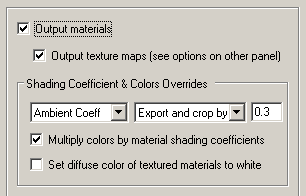
Output Materials
If this checkbox is checkmarked then materials will be exported to the DGN file and linked to each geometry item. A RGB entity color will also be linked to each geometry item. If this checkbox is disabled then only the RGB entity color will be output.NOTE: materials will be output as 'Microstation XM' internal materials (embedded within the DGN file) and not old-style externally linked .material and .palette files.
Material properties exported include:
- Ambient shading coefficient.
- Diffuse color and diffuse shading coefficient.
- Specular color and specular shading coefficient.
- Luminous shading coefficient (as DGN 'glow')
- Opacity
- Index of refraction
- Ray-trace reflection amount
- Phong shininess (power), mapped over to DGN 'Finish' value
The DGN file format does not allow for output of these common material attributes:
- Ambient color
- Luminous color
- No uv texture map coordinates for mesh geometry, at this time.
Output Texture Maps
If this checkbox is checkmarked then 2D texture maps that have been assigned to the material definition(s) will be exported to the DGN file. The "Texture Bitmaps" panel defines whether those texture images are to be fully embedded in the DGN file or only their references added to the file.At present only diffuse color and bump texture maps can be exported to DGN.
NOTE: 'diffuse' and 'bump' mapping texture image references can be output to DGN materials. However, at this time the official Teigha.DGN toolkit has no capability to output 'uv' texture coordinates along with each mesh polygon. As such, texture mapped polygons are not possible at this time.
Shading Coefficient and Colors Overrides
These combo boxes provide hands-on control over how exported material shading parameters should be modified so that the exported model can be rendered nicely as it would have looked in the source 3D program. The two combo boxes and the single numeric text box provide you good control over the ambient, diffuse, specular, luminous, opacity and shininess shading coefficients exported to DGN.The first drop-down combo box selects which of these shading parameters is to be modified. Each shading coefficient has its own operation that can be selected (via the second combo box) and an optional numeric text value (via the third data entry text input box). The following describes the various shading parameters that can be controlled:
Ambient Coefficient: This controls the amount of color reflected from an object based on the ambient light in a scene. A good default value is 0.1 through to 0.3 and ideally ranges from 0.0 to 1.0.
Diffuse Coefficient: This controls the amount of color reflected from an object based on the direct light shining on it. A good default value is 0.4 and ideally ranges from 0.0 to 1.0.
Specular Coefficient: This controls the intensity of the highlight color on an object. A good default value is 0.7 and ideally ranges from 0.0 to 5.0.
Luminous Coefficient: This controls how much color is added directly to an object, regardless of any light that shines on it (the higher the value, the more the object will appear to glow). In general this value should be kept at 0.
Opacity: This is the inverse of transparency. 0.0 will make the object fully transparent, while at 1.0 the object will be fully opaque.
Phong Shininess: This controls the width of the specular highlight seen on an object. An ideal range is 6 (very wide) to 300 (very narrow). The default is 32.
For each material shading parameter, several actions can be performed on each material shading parameter during the import process:
Do Not Export: When this option is selected, the shading parameter is set to 0, effectively making the shading channel appear black (for color channels).
Export Unchanged: When this option is selected, the shading parameter is exported as is, with no change.
Set and Use Default: When this option is selected, the shading parameter is set to some "good" default value (as determined by the export converter). This default value will be displayed in the input text box.
Set to Specific Value: When this option is selected, the exported shading parameter will be overridden with the user specified value of the numeric input text box.
Export and Crop by: When this option is selected, the shading parameter is exported and will remain unchanged if it is less than the numeric text input value shown on the dialog box. If it is greater, then the exported value will be clamped to be no greater than the numeric type-in value. This is a good operation, for example, if you do not wish for the ambient shading coefficient to be greater than 0.3.
Export and Scale by: When this option is selected, the shading parameter is exported and multiplied by the numeric input text value shown on the dialog box
Output Material Shading Coefficients
Inside Okino's internal scene graph each material has a "color" and a corresponding "shading coefficient" for each ambient, diffuse. luminous and specular color definition. The "shading coefficient" can be considered a variable intensity control that brightens or darkens its corresponding color, without having to modify the color itself.If this checkbox is checkmarked then the Okino shading coefficients will be mapped and output to these DGN material values:
- Okino ambient coefficient = DGN ambient intensity
- Okino diffuse coefficient = DGN 'Color' intensity (diffuse)
- Okino specular coefficient = DGN specular intensity
- Okino luminous coefficient = DGN glow intensity
- Okino Index of Refraction coefficient = DGN 'Refract'
- Okino ray trace reflection coefficient = Shown in Microstation as the Okino "specular" * the Okino "ray trace reflection coefficient" * 100.
If this checkbox is not checkmarked then only the raw colors will be output (ambient, diffuse and specular) to the DGN file and their corresponding shading coefficient values will be ignored. This will typically result in brighter, bolder and punchier materials, what we ourselves term "OpenGL" shading which tends to be more saturated than colors seen in photo-realistic rendering programs.
Set Diffuse Color of Textured Materials To White
This is one of those options that may come in handy for someone with particular requirements for their textured objects in the DGN file. It is patterned after a similar option from our OpenFlight export converter.If this checkbox is checkmarked then any material which has a diffuse texture map assigned to it will be output in such a way that its diffuse surface color will be set to white. This is useful because certain real time renderers use an "OpenGL" shading model in which the diffuse color is multiplied into the assigned texture map colors - if the diffuse material color is dark or black then the texture map will not be visible (often a problem when exporting from Maya for which the diffuse surface color is always set to black for textured materials). Enabling this option will cause the diffuse surface color to become white, and thus it will not affect the brightness of the assigned texture map.
If this checkbox is not checkmarked then the diffuse surface color will be exported unchanged.
This panel controls the output of 3D NURBS curves and 3D spline shapes. The NURBS curves are in no way related to the 2D trim curves of a NURBS surface.
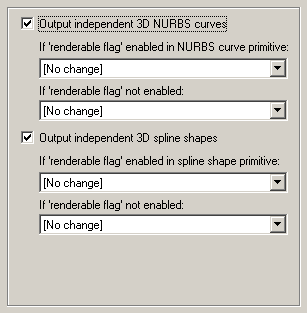
Output independent 3D NURBS curves
The NuGraf/PolyTrans 3D database has a very extensive NURBS curve sub-system. Each NURBS curve object can have 1 or more NURBS curves associated with it. Multiple curves inside a single object can either be considered to form a single continuous "composite" curve, or each curve can be considered unique, closed, planar (in world space) and oriented such that the curves of the object can be directly converted into a trimmed NURBS surface (in other words, the first curve forms the boundary of the surface and subsequent closed curves form the holes).The following options control how the various NURBS curve configurations can be converted during the export phase. An extensive internal NURBS curve conversion and cross-conversion system exists.
If 'renderable flag' enabled in NURBS curve primitive:
If the 'renderable' flag of a NURBS curve primitive is internally enabled, and the curve(s) form closed loops, then it is possible to convert the NURBS Curve primitive into a 3D format that is renderable: either a mesh, a trimmed NURBS surface or a Spline Shape. The following options define what will be done to NURBS Curves primitives during the export phase when their 'renderable' flag is enabled:
[No Change]
No change. The NURBS Curve primitive will be exported as-is.Convert and Output as Polygon Mesh
The NURBS Curve primitive will be converted into a mesh object prior to export.Convert and Output as Trimmed NURBS Surface
The NURBS Curve primitive will be converted into a corresponding trimmed NURBS surface (patch). If the conversion process cannot be made then it will be output as a polygon mesh instead.If 'renderable flag' not enabled:
If the 'renderable' flag of a NURBS Curve primitive is not enabled then the curves will be considered just as plain curves that cannot be seen when rendered. In this case, the following options define what will be done to NURBS Curves primitives during the export phase when their 'renderable' flag is disabled:
[No Change]
No change. The NURBS Curve primitive will be exported as-is.Output Composite NURBS Curve as a Single Curve
No change except in the case when the NURBS curve primitive is defined as a single composite curve made up of multiple curve segments. In this case the multiple curve segments will be temporarily converted to a single NURBS curve before export.Output independent 3D spline shapes
The NuGraf/PolyTrans 3D database has a very extensive spline primitive sub-system. This primitive accommodates one or more spline curves per primitive. If the multiple spline curves are each closed then the overall Spline Shape is termed "renderable" and can be thus converted into a polygon mesh or a corresponding trimmed NURBS surface (patch). For example, the letter "B" can be defined by 3 Bezier curves, the first forming the outer boundary and the latter two forming holes. Note, that unlike the NURBS Curve primitive, each spline curve of the Spline Shape is composed of only a single curve segment (no composite spline curves are allowed).The following options control how the various Spline Shape configurations can be converted during the export phase.
If 'renderable flag' enabled in spline shape primitive:
Convert and Output as Polygon Mesh
The Spline Shape primitive will be converted into a mesh object prior to export.Convert and Output as Trimmed NURBS Surface
The Spline Shape primitive will be converted into a corresponding trimmed NURBS surface (patch). If the conversion process cannot be made then it will be output as a polygon mesh instead.If 'renderable flag' not enabled:
Convert and Output as a NURBS Curve Object
Each spline curve of the Spline Shape primitive is resampled into a corresponding NURBS Curve segment and placed into a single NURBS Curve primitive. The 'renderable' flag of the new NURBS Curve primitive will be disabled. The final NURBS Curve primitive will look similar (within an error tolerance) to the original Spline Shape.
These options allow geometry processing, manipulation and optimization operations to be performed on the mesh data prior to export to DGN.
NOTE: These operations are performed on temporary copies of the mesh data and not on the original mesh data as contained internally within the Okino 3D scene graph. In other words, performing successive DGN file exports will not modify nor touch the original 3D scene data.
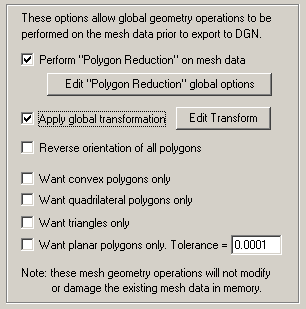
Perform "Polygon Reduction" on mesh data
If this checkbox is enabled (check-marked) then the DGN exporter will apply the global polygon reduction algorithm to each mesh object just prior to them being embedded in the DGN file.The algorithm allows the number of polygons in the scene to be greatly reduced. The parameters used to reduce the polygons can be modified by pressing the "Edit Polygon Reduction Global Options" button. Press the "Help" button on its corresponding dialog box to learn more about the polygon reduction system.
Apply global transformation
If this checkbox is enabled then a general purpose global transformation will be applied to each exported DGN scene. This new transformation matrix will be applied to the root node in the exported DGN file.This option will allow you to, for example,
- Re-center all of the geometry so that it is centered at the origin (0,0,0) in the DGN file.
- Move all of the geometry so that it is sitting on the Y=0 (XZ) horizontal plane.
- Auto-scale the geometry so that it is no larger than a specific bounding box size.
- Scale the scene by a (X, Y, Z) value.
- Shear the scene by a (X, Y, Z) value.
- Rotate the scene by a (X, Y, Z) value.
- Translate the scene by a (X, Y, Z) value.
The transformation can be edited by pressing the "Edit Transform" button which will cause the following global transformation dialog box to appear:
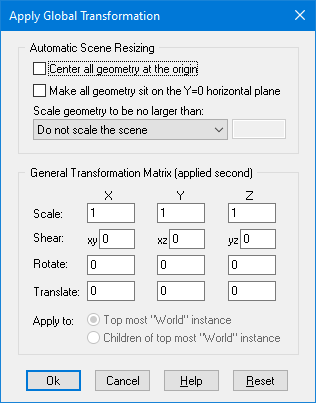
The transformation matrix will be computed in two phase: (1) the transformations specified in the top "Automatic Scene Resizing" section, then (2) the single transformation specified in the "General Transformation Matrix" section.
The values on the dialog box are described as follows:
Automatic Scene Resizing
Center all geometry at the origin
If this checkbox is enabled (checkmarked) then all the geometry data will be positioned so that it is centered about the origin. If disabled then the geometry will not be repositioned.Make all geometry sit on the Y=0 horizontal plane
If this checkbox is enabled (checkmarked) then the geometry will be repositioned so that it is sitting flush with the top of the Y plane (the horizontal plane).Scale geometry to be no larger than:
This option allows the geometry data to be automatically rescaled if it is too large. If set to 'Do not scale the geometry' then no scaling will be done. If set to '1x1x1 units' then all the objects will be scaled smaller should they exceed 1x1x1 units in total size. Likewise for the '2x2x2 units' option. If set to 'User defined maximum size' then the maximum size of all the objects can be set using the type-in numeric box. The default is '2x2x2 units'.Although not quite the same, if the option is set to ‘Use Absolute Scaling Factor’ then all objects exported to the DGN file will be scaled absolutely by the user specified value. Thus, if you set the type-in value to 0.25 then all objects will be made 4 times smaller and if the value if set to 4 then all objects will be scaled 4 times larger. This is useful is you are converting a variety of different models to DGN format and you want them all uniformly scaled with the same scaling factor.
Transformation Matrix Values
Translate X, Y, Z
This applies a 3D translation by the specified amounts in the X, Y and Z dimensions.Scale X, Y, Z
This applies 3D scaling in the X, Y and Z dimensions. All 3 scale factors must be non-zero. Values above 1.0 will make the scene larger (2.0 will double the size of the scene) while values less than 0 will make the scene smaller (0.5 will half the size of the scene).Shear XY, XZ, YZ
This applies a linear shear in one of 3 directions:XY will shift all points in the X direction by the specified amount in proportion to the distance the points are located along the positive or negative Y axis. For example, using a value of 2.5 will shear all points by 68 degrees in the positive X direction; in other words, for every unit increase in the Y direction the X points will be shifted by 2.5 units.
XZ will shift all points in the X direction by the specified amount in proportion to the distance the points are located along the positive or negative Z axis.
YZ will shift all points in the Y direction by the specified amount in proportion to the distance the points are located along the positive or negative Z axis.
Rotate Around X Axis
Rotate Around Y Axis
Rotate Around Z AxisThis applies a rotation about the X, Y and/or Z axes. The rotation angle is restricted to the range -360 to 360 degrees. The angle of rotation is counter-clockwise when viewed from the positive to negative axis of rotation.Reverse orientation of all polygons
If this option is enabled (checkmarked) then the orientation of all polygons will be reversed, indirectly causing the vertex normals to also face in the opposite direction. For example, if the vertex normals of the object currently all face inward then this function will cause all of the vertex normals to face outward, and cause the orientation of each polygon to flip between clockwise and counter-clockwise.Want convex polygons only
Checkmark this checkbox to cause non-convex polygons to become triangulatedWant quadrilateral polygons only
Checkmark this checkbox to cause 5 or more sided polygons to become triangulatedWant triangles only
Checkmark this checkbox to cause all polygons to be triangulated prior to output.Want planar polygons only. Tolerance = #
Enabling this option (which is the default) will cause all mesh objects to be examined and those polygons which are deemed non-planar (to a tolerance level) will be triangulated.The "tolerance" value determines how far away a vertex of the polygon must sit from the averaged plane of the polygon before the polygon can be considered non-planar. This value is measured in object-space of the mesh object (before the mesh is scaled and translated into its final world-space location).
This dialog box controls how referenced bitmap files will be handled during the export process. The three options are basically:
1. Do not modify the bitmap filename reference and do not perform any bitmap conversion. This is useful if your bitmaps are already in a format recognized by the destination 3D program.
2. Perform bitmap conversion for those file formats not recognized by the destination 3D program and change the file extension of the bitmap. For example, if exporting to a file which references a bitmap called 'brick.iff' (in the Amiga IFF file format), then this dialog box can enable the export converter to convert the Amiga IFF bitmap file to a recognized file format such as TIFF.
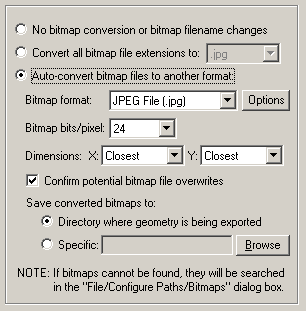
No Bitmap Conversion or Bitmap Filename Changes (Radio Button)
If this radio button is chosen then any exported bitmap references will not be changed, its filename extension won't be changed, the path to the bitmap will not be changed and no bitmap conversion will be done.Convert all Bitmap File References To... (Radio Button)
Rather than convert referenced bitmap images to another file format this radio button (when selected) simply changes all the file extensions on bitmap files to a specific type. For example, if set to 'TIFF' then all exported bitmap filenames will be changed so that their file extensions end in '.tif'. This is a useful option is you already have all of the referenced texture maps converted to the desired file format.Auto-Convert Bitmap Files to Another Format (Radio Button)
If this radio button is selected then all 2d bitmap textures which are currently defined and referenced by the internal NuGraf/PolyTrans database scene will be automatically tagged then converted to a new user-specified 2d bitmap file format. For example, if the scene makes references to IFF bitmap files then this option can be enabled so that the IFF images get converted to TIFF format automatically.If the bitmap texture(s) cannot be found in the location specified by the pathname prepended to the texture filename then the export converter will search for the texture(s) in all directories specified in the file search paths (these can be modified by choosing the "File/Configure Paths" dialog box and clicking the 'Bitmaps' tab).
Bitmap File Format (Combo Box)
This combo box lists the destination bitmap file format.Bitmap Bits/Pixel: 2, 4, 8, 24 (Combo Box)
This combo lists determine the number of bits/pixel to write out to the new 2d bitmap file. The default is 24 bits. A color quantization algorithm will be used for the 2, 4 and 8 bits/pixel output formats. Not all bitmap file formats can accept 2-8 bits/pixel (in particular JPEG).Dimensions: X = #, Y = #
These two drop-down list boxes determine the X and Y resolution for the converted bitmap file(s):
No Change = Do not change the X or Y size Closest = Use the next highest power-of-2 size 2, 4, 8, ... 256, 512 = Choose a specific size for the X or Y dimension Confirm Potential Bitmap File Overwrites
If this checkbox is enabled (checkmarked) then the bitmap converter will confirm any potential overwrites of existing bitmap files on disk which have the same filename and extension as the one being written. If this option is disabled then no confirmation will be made.Save Converted Bitmaps To...
These radio buttons determine where the new bitmap file will be written to. Note that enabling the "Replace all Bitmap File Paths With This Path" option or the "Strip File Paths From All Bitmap References" option below will change the path prefix for the converted bitmap even though it was saved to disk in the location specified by one of these 3 radio buttons.Directory Where Geometry Is Being Exported
The new bitmaps will be written to the directory where the exported files are being written to.Specific + Browse
The new bitmaps will be written to the directory specified by the text box. This directory can be changed by press the 'Browse' button.
This panel controls how bitmap file paths will be processed before being placed in the exported file. File paths are used to proceed bitmap image filenames and basically allow specific directory or URL paths to be assigned to a bitmap image.
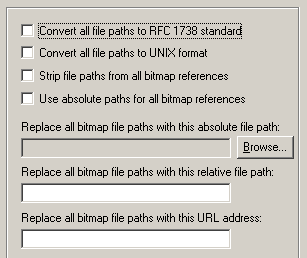
Convert all file paths to RFC1738 Standard
If this option is enabled (checkmarked) then all bitmap file paths written to the file will be converted into the "RFC 1738" URL format specification. This option is only used in the VRML2 exporter and is provided in this exporter for convenience.This option will override the "Convert all file paths to UNIX format" when enabled. However, the conversion to RFC1738 will not be done when a valid string is specified for the "Replace all Bitmap File Paths With This URL Address" option below (since it is assumed the URL address string specified is already in RFC1738 format). As examples:
C:\polytrans\bitmaps\texture.tif --> file:///C|/polytrans/bitmaps/texture.tif
\\machine\polytrans\bitmaps\texture.tif --> file:////machine/polytrans/bitmaps/texture.tif
Convert all file paths to UNIX format
If this option is enabled (checkmarked) then all bitmap file paths written to the file will be converted to a UNIX compatible format (it will not take effect if the "Convert all file paths to RFC1738 Standard" option is enabled). In particular, all DOS-specific backward slashes '\' will be converted to UNIX forward slash '/' directory separators. Also, any DOS-like drive specifiers, such as 'c:\' will be removed from the file path and a warning message will be reported about the removal of this drive specifier (you should make sure that all DOS-like drive specifiers be replaced by UNC specifiers, such as \\machine1\). If this option is disabled then no conversions will be made.Strip File Paths from All Bitmap References
If this option is enabled (checkmarked) then any file paths on a bitmap reference will be stripped off. For example, "C:\polytrans\bitmaps\texture.tif" will be output as "texture.tif".Replace all Bitmap File Paths With This Absolute File Path:
This option allows all exported bitmap references to be prefixed with a new filepath. This might be useful, for example, if all of your bitmap files are located in one specific directory or if you wish to change the prefix on the imported bitmap references. This new path will override all other options on this bitmap conversion dialog box (in other words, it will replace a bitmap's file path regardless of any other file path added to the bitmap via other options in this dialog box). To choose the filepath press the 'Browse' button. To disable this option type any character into the "Replace all Bitmap File Paths With This URL Address" type-in line, then delete that character.Replace all Bitmap File Paths With This Relative File Path:
This is the same as the previous "Replace all Bitmap File Paths With This Absolute File Path" option except that you can specify any arbitrary file path by typing the text into the type-in field. Whereas the previous method only allowed absolute file paths (ie: "C:\polytrans\bitmaps\texture.tif"), this option allows for relative file paths (ie: "bitmaps\texture.tif"). To disable this option, delete all text in the type-in field.Replace all Bitmap File Paths With This URL Address:
If this option is enabled (checkmarked) then all bitmap filenames (used in association with a texture map) will be prefixed with the string specified in the URL input edit box. For example, if a texture references the filename:c:\files\textures\bitmap.tifwithin this program’s database, and the URL is specified on this dialog box as:http://www.okino.com/images/then the bitmap filename will be stored in the file as:http://www.okino.com/images/bitmap.tif




